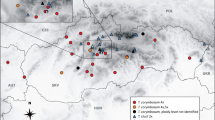Abstract
The present paper deals with cytotaxonomy ofChelidonium majus L. s. 1. taxa and their hybrids. Based on results of hybridization experiments, cytology and reproductive isolation, a new combination,Ch. asiaticum (Hara) Krahulcová, is proposed. The structure of the aggregate is as follows:Ch. majus L. subsp.Majus (2n=12, distributed in Europe),Ch. majus L. subsp.grandiflorum (DC.)Printz (2n=12, S. Siberia, China) andCh. asisaticum (2n=10, E. Asia). Karyotypes ofCh. m. subsp.grandiflorum andCh. asiaticum are compared in detail.
Similar content being viewed by others
References
Dahlgren K. V. (1918): Über einige Kreuzungsversuche mitChelidonium majus L.,Polemonium coeruleum L. undLactuca muralis L.—Svensk Bot. Tidskr., Stockholm, 12: 103–107.
Darlington C. D. (1956): Chromosome botany.—London.
Darlington C. D. etWylie A. P. (1955): Chromosome atlas of flowering plants.—London.
Domin K. (1947): Pracovní metody soustavné botaniky.—Praha.
Fedde F. (1909):Papaveraceae-Hypecoideae etPapaveraceae-Papaveroideae. In:Engler A.: das Pflanzenreich—Regni vegetabilis conspectus. IV. Vol. 104.—Leipzig.
Fedorov A. A. (red.) (1969): Chromosomnyje čisla cvetkovych rastenij.—Leningrad.
Gadella T. W. J. (1972): Cytological and hybridization studies in the genusSymphytum.—In:Vida G. (red.): Evolution in plants. Symp. Biol. Hung. 12: 189–199.
Hara H. (1949): An East-Asiatic representative ofChelidonium majus L.—J. Jap. Bot., Tokyo, 23: 43–50.
Jinno T. (1963): Morphological variation of chromosomes inChelidonium majus I.—Bot. Mag., Tokyo, 76: 115–119.
Jinno T. (1969): Cytological studies ofChelidonium. III. Karyotypes of the clones with different chromosome numbers and of their hybrids between these clones.—Mem. Ehime Univ. Nat. Sci., Ser. B (Biol.), 6: 57–61.
Jinno T. (1971): Hybrids produced from Japanese species ofChelidonium majus L.—Kromosomo, Tokyo, 85–86: 2705–2712 [n. v., sec. Biol. Abstr. 55/2: No. 8097, 1973].
Kitagawa M. (1979): Neo-Lineamenta florae Manshuricae.—Vaduz.
Kožucharov S., Popova M. etKuzmanov S. (1968): Cytotaxonomic studies on Bulgarian flowering plants.—Genet. i Selekc., Sofia, 1: 251–255.
Kurosawa S. (1979): Notes on chromosome numbers of Spermatophytes (2).—J. Jap. Bot., Tokyo, 54/5: 155–160.
Meusel H., Jäger E. etWeinert E. (1965): Vergleichende Chorologie der zentraleuropäischen Flora.—Jena.
Měsíček J. etSoják J. (1969): Chromosome counts of some Mongolian plants.—Folia Geobot. Phytotax., Praha, 4: 54–83.
Nagao S. etMasima I. (1944): Studies on the chromosomes ofChelidonium majus L. III. Variation of karyotypes found in plants coming from different localities.—Jap. J. Genet., Tokyo, 20: 59–63.
Nagao S. etSakai K. (1939): Association of chromosomes inChelidonium majus L.—Jap. J. Genet., Tokyo, 15: 23–28.
Popov M. G. (1937):Papaveraceae. In: Flora SSSR, Tom VII, p. 573–717.—Moskva et Leningrad.
Prain D. (1895): A revision of the genusChelidonium.—Bull. Herb. Boiss., Genève, 3: 570–587.
Skalińska M. et al. (1971): Studies in chromosome numbers of Polish angiosperms. Eight contribution.—Acta Biol. Cracov., Kraków, Ser. Bot., 14: 55–102.
Stebbins G. L. (1971): Chromosomal evolution in higher plants.—London.
Thaler J. (1959): Ein neues Vorkommen vonChelidonium majus L. var.fumariifolium (DC.)Koch in Graz.—Österr. Bot. Z., Wien, 106: 354–356.
Vries H. de (1903): Die Mutationstheorie. II.—Leipzig.
Author information
Authors and Affiliations
Rights and permissions
About this article
Cite this article
Krahulcová, A. Cytotaxonomic study ofChelidonium majus L. s. l.. Folia geobot. phytotax. 17, 237–268 (1982). https://doi.org/10.1007/BF02855710
Received:
Issue Date:
DOI: https://doi.org/10.1007/BF02855710




